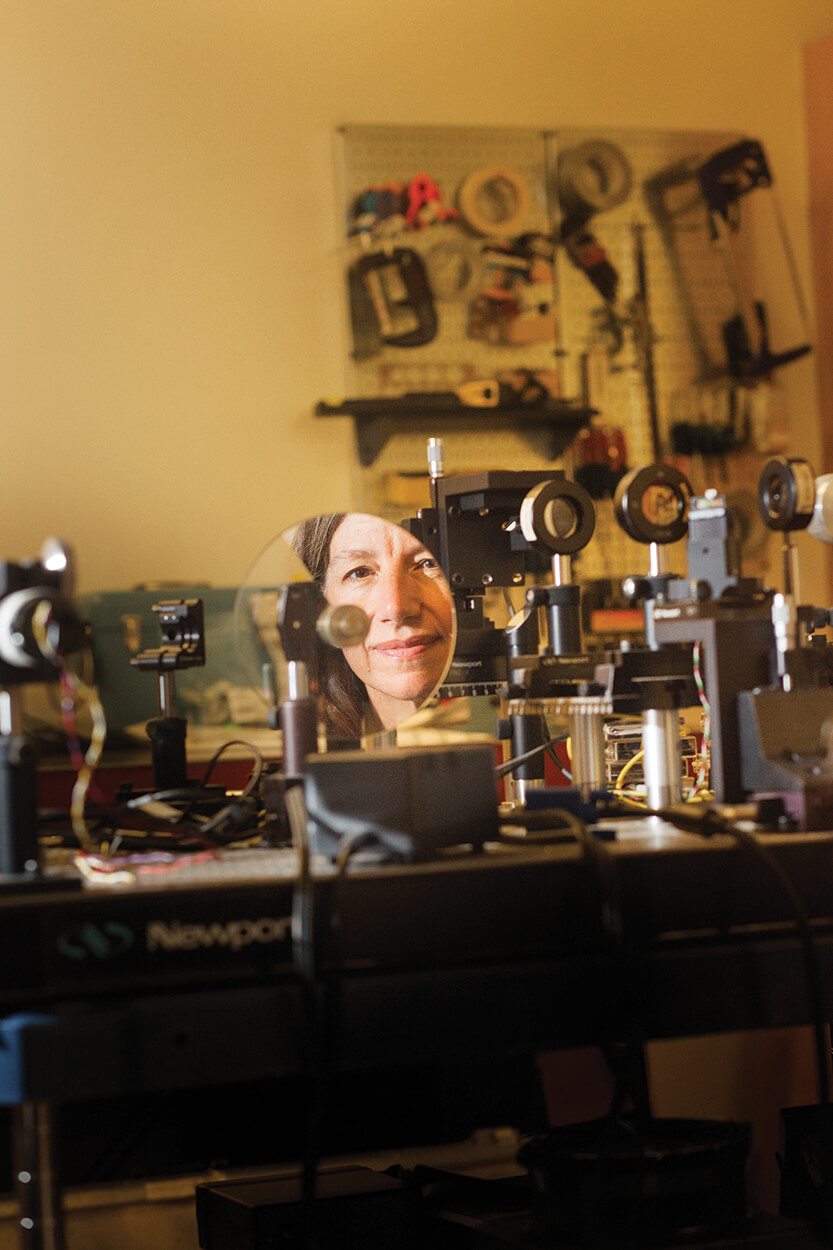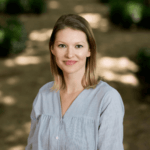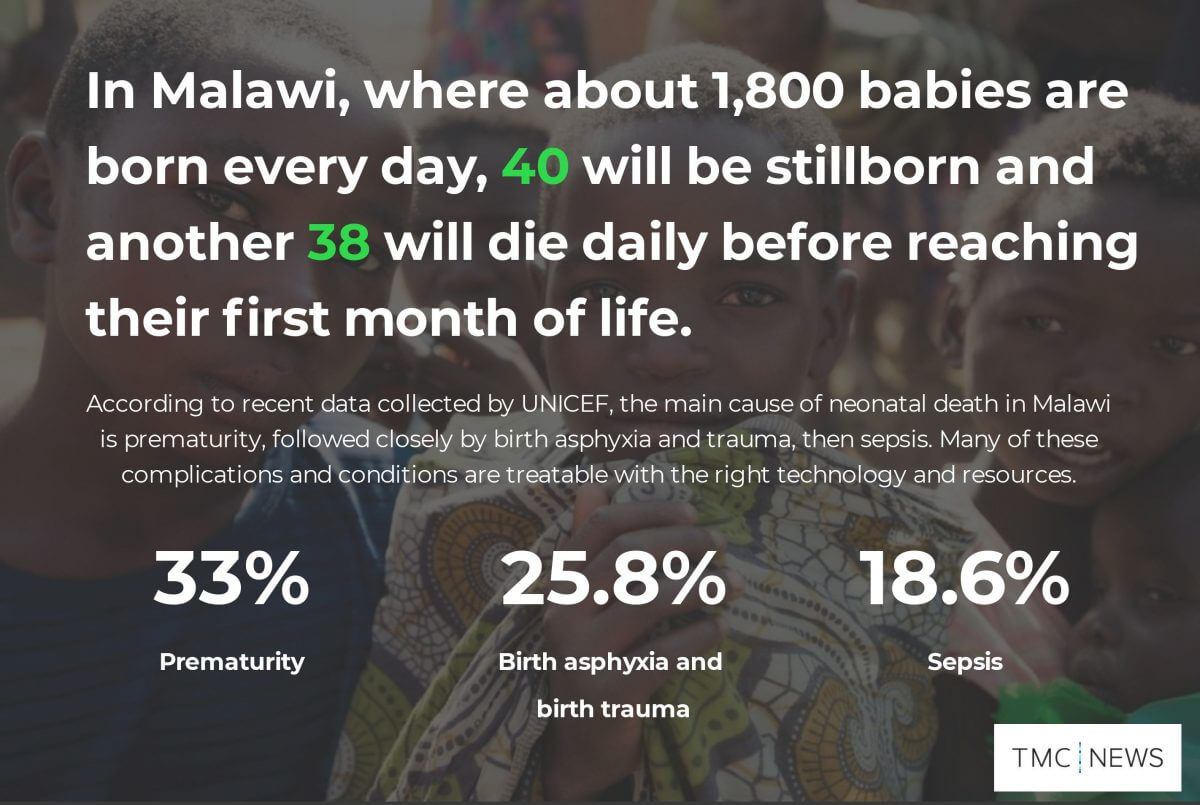The Engineer: Rebecca Richards-Kortum, Ph.D., creates simple machines that save lives
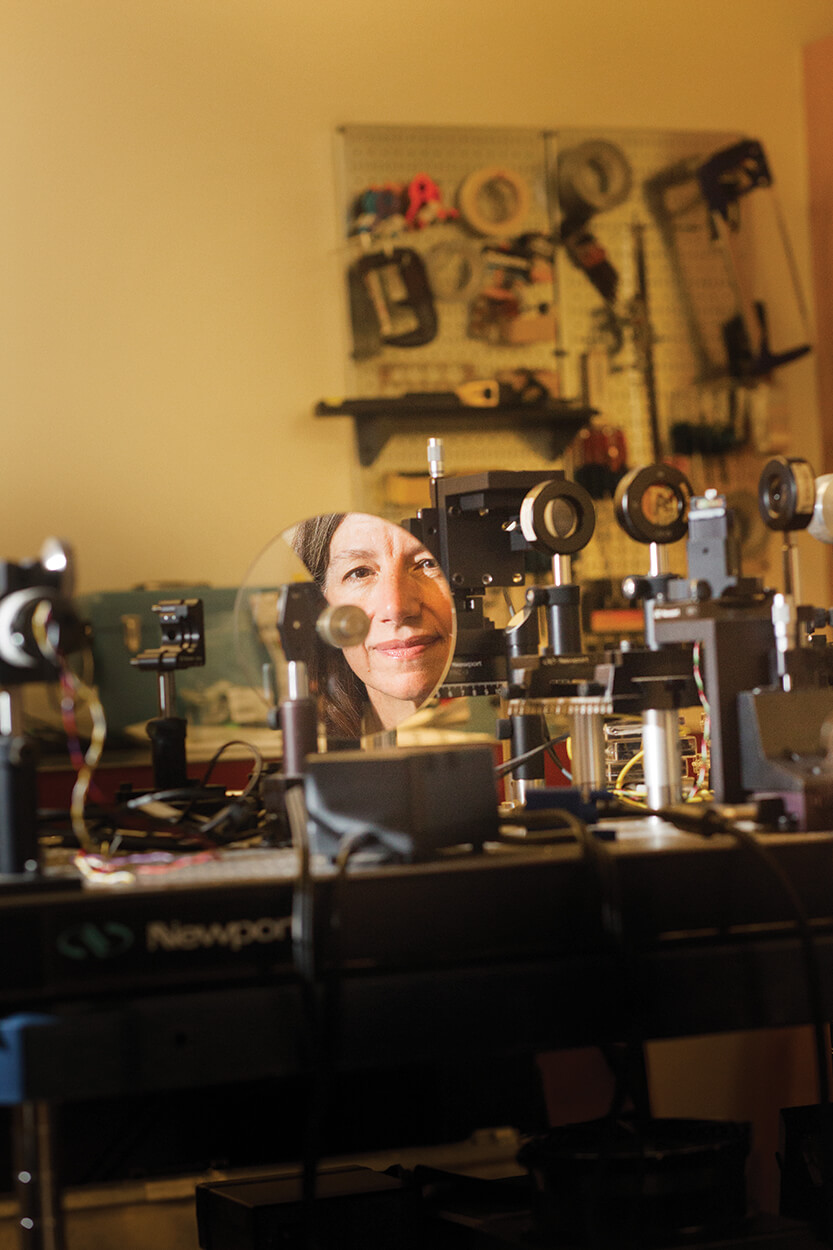
Two years ago on Halloween, Rebecca Richards-Kortum, Ph.D., a professor of bioengineering at Rice University, walked into her lab and stopped abruptly. Staring back at her was a crowd of familiar characters.
Her students, who wear costumes for the holiday every year, had conspired to go as different versions of their mentor. There was the mother-of-six Rebecca, the saving-dying-babies-in-Africa Rebecca, the marathon-runner Rebecca, even the Albert-Einstein Rebecca—a nod to the $625,000 fellowship Richards-Kortum received from the MacArthur Foundation. Commonly known as a “genius grant,” the stipend is paid out over five years to support visionaries in their creative pursuits for the benefit of humanity.
An honor of a lifetime, the MacArthur sits atop a long list of accolades Richards-Kortum has collected over more than three decades as a physicist, bioengineer and global health pioneer. She has developed 40 patents, authored numerous research papers and book chapters, and has been awarded grants from organizations that range from the National Institutes of Health to the U.S. Department of Defense and the Bill & Melinda Gates Foundation. In 2017, she was included on Fortune magazine’s list of 50 World’s Greatest Leaders— alongside the likes of Pope Francis, Angela Merkel and Shakira—for her efforts to end preventable newborn deaths in Africa. And in June of this year, she was selected to serve as a Science Envoy for the U.S. Department of State—one of only 23 scientists ever to receive the honor.
“She seems to have boundless energy,” said her husband, Philip Kortum, Ph.D. “She’s up at 5:30, out sitting on the couch or in front of the fireplace working, and seems to be able to sustain that for just endless periods of time. She’ll essentially sprint all day long, squeeze in a 12-mile run, and then work until it’s finished. And she won’t just do that for a couple of days to get a project done, but she’ll do that again and again and again and again.”
Part of Richards-Kortum’s genius lies in channeling her energy. A strategic thinker with a competitive spirit, she identifies a goal and then marches toward it, assembling an army of collaborators and building a plan of action so direct and so fundamentally sound that everyone around her wonders why no one thought of it sooner.
But nothing about her work is easy, and bringing her plans to fruition is another story entirely.
‘Just Becky Richards’
As a young girl in Nebraska, Richards-Kortum dreamed of becoming a novelist. She cherished books like A Wrinkle in Time, Harriet the Spy and The Little Prince. But in high school, she found herself drawn to math and science. When it came time to pick a major at the University of Nebraska-Lincoln, Richards-Kortum chose physics because, as she put it, it was the hardest thing she could do.
“I was so fortunate that the person who taught the freshman physics class I took, Paul Burrow, was this amazing teacher,” Richards-Kortum said earlier this year in her office at Rice University’s BioScience Research Collaborative. Now in her early fifties, she keeps her hair just past her shoulders and wears a round black running watch that she doesn’t check as often as you’d expect.
“He’s one of the best teachers I ever took a class from—ever,” she added. “He made it so engaging and fun.”
Not long after, when the chairman of the physics department, David Sellmyer, encouraged her to work in his lab, Richards-Kortum discovered her love for applied science.
“He was a hugely important mentor, and he totally changed the direction of my career,” she said. “What I took away from that is the power that one person can have on the direction of other people’s lives. I try not to forget that as a mentor and as a teacher.”
She met Philip Kortum freshman year. They lived in the same building, she in room 2211 and he in 2311, right upstairs.
“We didn’t actually meet in the dorm, though,” said Kortum, now an associate professor of engineering psychology and human factors at Rice University. “Someone else on my floor had taken her to a party and then had consumed enough alcohol that he was unable to take her home, so I offered, and we just really hit it off. It was just one of those things—I kind of knew from the minute I met her that she was awesome.”
The couple got married the day after they graduated.
“We took finals on Friday, graduated on Saturday, then got married on Sunday,” Kortum recalled. “We just had a one-day honeymoon right there, because then we had to pack up the U-Haul and head out to Boston so she could go to MIT. I should have looked at that and said, ‘This is going to be indicative of the pace that life is going to take with Rebecca.’”
Of course, neither of them knew what the future had in store.
“Back then, she was just Becky Richards,” Kortum said. “She was just a physicist and I was just an engineer. I think that’s one of the reasons we’ve got such a fabulous marriage. When we went out to Boston, we didn’t have two dimes to rub together. We owned a lawn chair and a mattress.”

Rebecca Richards-Kortum, Ph.D., in her office at Rice University’s BioScience Research Collaborative.
Equipment graveyards
After wrapping up MIT with her M.S. in physics and a Ph.D. in medical physics, Richards-Kortum took a job at The University of Texas at Austin as a professor of biomedical engineering. She spent 15 years immersed in optical imaging research geared toward early detection of cervical, oral and esophageal cancers before leaving for Rice University in 2005.
In Houston, Richards-Kortum found herself looking for creative ways to engage her bioengineering students in projects that would have a more immediate impact on the world. She was invited by Mark Kline, M.D., now physician-in-chief of Texas Children’s Hospital, to the opening of the Baylor International Pediatric AIDS Initiative clinic in Malawi to explore potential opportunities for her undergraduate students to address some of the challenges African clinics faced in delivering care.
The experience changed her life.
“That was really a transformational trip because I saw two things,” said Richards-Kortum, who speaks evenly, almost always projecting a sense of calm. “I saw the heart-breaking, normal situation for hospital-based care for newborns, but what I saw right adjacent to that was this huge failure of existing technologies that were being imported that couldn’t withstand the heat, the dust, the humidity, the lack of trained technicians, the lack of supply chain for spare parts.”
Donated technologies can save lives in parts of the world with reliable electricity, spare parts and controlled environments. But in less fortunate areas, as soon as a critical component breaks or the electricity sputters, high-tech machines can no longer keep infants warm, measure oxygen or pump air into tiny lungs. The machines are rendered useless and set aside, piling up into equipment graveyards. In Africa, Richards-Kortum saw them everywhere.
Upon returning from Malawi, Richards-Kortum recruited her colleague, fellow bioengineering professor and director of the Oshman Engineering Design Kitchen (OEDK) at Rice, Z. Maria Oden, Ph.D., to help engage undergraduate students to create solutions for real-world engineering problems. The two also now serve as co-directors of the Rice 360° Institute for Global Health, a program that works in conjunction with the OEDK to foster new technologies for health challenges in the developing world.
“It took us a while, honestly, to figure out what was the best way to engage our team and make a difference,” Richards-Kortum said. “We did a lot of things that didn’t work and learned what could work. And really, what we learned was to focus on a place in the health care system and focus on a place geographically. We applied those lessons to this focus on newborns and a focus on sub-Saharan Africa.”
The key was to create machines tailor-made to low-resource settings: they needed to be affordable, capable of withstanding harsh environments and repairable with limited tools and resources.
A mother herself, Richards-Kortum knew that childbirth could be traumatic under the best of circumstances, but she couldn’t live with the odds for newborns in sub-Saharan Africa. In Malawi alone, where about 1,800 babies are born every day, 40 will be stillborn and another 38 will die daily before reaching their first month, according to recent data collected by the United Nations Children’s Fund, known as UNICEF.
Surely, Richards-Kortum thought, we can fix that.
More space
Originally, Richards-Kortum and her husband weren’t interested in having children of their own. But then one day in graduate school, she changed her mind.
“She probably remembers it differently, but I just remember one day she woke up and said, ‘I think we should have children,’” Kortum recalled. “We’re sort of careful, considerate thinkers and planners. And so, we had big discussions about it and we decided, yeah, maybe this would be a good thing to do.”
“It was a process of convincing him at every stage,” Richards-Kortum said, laughing. “The first baby my husband ever held was ours.”
The couple now has six children, ages 8 to 26: three boys and three girls, two of whom they adopted from orphanages in Ethiopia. The idea of adding two more to their family first gripped Richards-Kortum after a trip to Africa.
“I came home and I was like, ‘You know, we really have more space, in every sense of the word,’” she said.
As part of the adoption process, their biological children joined them on trips to Ethiopia to meet their future sisters.
“It was good that our kids were able to go over and see firsthand what was going on and why there was such a big need,” Kortum said. “It just breaks your heart when you go into the orphanages. You want to help all of them. It’s heartbreaking because you realize, you can help in small ways, but helping in big ways is harder.”
But tackling big problems is what Richards-Kortum does best.
“Everybody in the family understands what Rebecca’s doing and why it’s important,” Kortum said. “Everybody also understands that when Mom has to go to Africa, it’s for a good reason. And certainly, I think, a lot of that was brought home when we adopted our two youngest children. That sort of solidified in my biological children’s minds that this wasn’t just a job—this was a lifelong commitment to bettering the world. I think it’s made them more empathetic to the fact that you’ve got to use your talents for the greater good.”
For Richards-Kortum, though, it’s more than that. She is a formidable force, and she never steps down from a challenge. Her husband recounted a time during the adoption process when social workers visited their Houston home to interview their biological children.
“In one of those interviews, they asked my children, ‘What’s the one word that would describe your mother?’” Kortum recalled. “And they said, ‘Competitive.’”

Richards-Kortum in her lab at the BioScience Research Collaborative.
An entire toolkit
One of the first inventions Richards-Kortum and her team created for newborns in sub-Saharan Africa was a continuous positive airway pressure machine, known as a CPAP, an essential tool in any neonatal intensive care unit (NICU) for helping newborns who have problems breathing. The students managed to keep production costs around $350 per machine, whereas a typical CPAP runs upwards of $6,000. Initially prototyped using a Nalgene water bottle and a shoe box, the simple design requires minimal maintenance, with flow coming from an air pump and pressure provided by a newer, mass-produced version of the original plastic bottle. After introducing the machine to one hospital in Malawi, the newborn mortality rate there dropped dramatically.
“I think, somewhat naively, we thought that once we scaled the CPAP, that would be good work done and that would really be the end of what we intended to do,” Richards-Kortum said.
But after disseminating their CPAPs to district hospitals, Richards-Kortum and her team learned that creating one machine that solved one problem simply wasn’t enough. In order to deliver quality, comprehensive newborn care, they needed an entire toolkit.
“Just because a baby has breathing problems, if you treat that alone, if they’re cold or they’re hypoglycemic or they’re jaundiced, they don’t do well. We saw that babies weren’t doing as well as they could and we met so many clinicians who were very frustrated. They didn’t have the tools they needed to do their jobs,” Richards-Kortum said.
And so, Richards-Kortum and her team have set out to assemble this toolkit. Dubbed NEST360°, the suite of 17 technologies will save an estimated 500,000 newborns every year—half the current mortality rate for newborns in sub-Saharan Africa.
In addition to the CPAP, the toolkit includes tailor-made devices like a radiant warmer and incubator to help infants maintain their body temperature; diagnostic tools for glucose monitoring, sepsis and infections; a spectrometer that can provide quantitative measurements for bilirubin, PH levels and hemoglobin in the blood within approximately 30 seconds; monitors for breathing, oxygen levels and temperature; a low-cost and low-power syringe pump to help supply medicine, fluid or formula; and a unique phototherapy machine that helps treat jaundice. If left untreated, jaundice can cause brain damage or death, and NEST360°’s diagnostic tool can detect the condition at the bedside in less than two minutes, with one drop of blood. Each test costs only five cents.
The full toolkit is estimated to cost 10 times less than the tools and machines used in high-resource settings, including NICUs across the U.S.
“What was both amazing and exciting to me was when you cost out how much it would be to deliver that suite of technology, it turns out to be $1.50 per each baby born at the hospital,” Richards-Kortum said. “It’s just crazy that for that small amount, these tools are not available. I think it could be as cost-effective and as lifesaving as vaccines.”
Kortum offered his analysis of his wife’s work and impact.
“She started to see that there was this whole realm of global health where she could attack the heart of some problems,’’ he said. “It’s kind of interesting because when you see the end devices, a lot of people say, ‘Well, gosh, it’s so simple, anybody could have thought of that.’ And then the question is, well then, why didn’t anybody, and why do devices in the United States cost 10, 20, 30 times more and not work as well? Because it is hard. It’s super hard.”
It was, in fact, the hardest thing she could do.
Sacred time
Richards-Kortum’s work takes her to Africa about four times a year, and she is gone for her fair share of domestic travel, too. She tries not to be away from family for more than 10 days at a time, but with 30-plus hours of travel from Houston to Malawi, it’s not always easy. So she wrings every second out of every day.
“When everyone else is watching in-flight movies, Rebecca is on the laptop,” said Sharmila Anandasabapathy, M.D., one of Richards-Kortum’s research collaborators who serves as director of Baylor Global Initiatives and the Baylor Global Innovation Center at Baylor College of Medicine. “She balances everything—kids, a dog, exercise. I think she’s one of the most balanced people I’ve ever met.”
Yet amid her frenzied schedule, Richards-Kortum still makes time to be available.
“She doesn’t have a minute to spare, but she always, always has time for everyone,” said Kathleen Schmeler, M.D., an associate professor in the department of gynecologic oncology and reproductive medicine at The University of Texas MD Anderson Cancer Center who has worked with Richards-Kortum on projects related to cervical cancer prevention and early detection. “Everyone loves working with her and for her, for that reason. Even if you’re the first-year graduate student in her lab of all these superstars, you’re a very important person, and are made to feel that way.”
Richards-Kortum tries to be protective of evenings and weekends, and each year in August she unplugs for a few weeks to vacation with her husband and the kids. Everyone knows that is sacred time—don’t text, don’t email, don’t call. Still, like most busy mothers, she is constantly re-evaluating how best to balance her responsibilities.
“The thing that I’ve really come to, in the last few years especially, is thinking about focusing time on things that matter,” Richards-Kortum said. “It can be professional or it can be personal, but I think it’s really easy to let email take over your day, and whatever’s in your inbox becomes your to-do list, and then someone else is in charge of your priorities. And so really thinking about, how do you make sure that you’re allocating your energy and your time in a way that is consistent with the things that are fundamentally important to you?”
One way? By making lists. Richards-Kortum likes to check things off, and sometimes she’ll make two lists just so she can check things off twice. She tries to think about her goals for the year, for the month, the week and the day.
“I have a colleague and she makes her to-do list, and she makes her not-to-do list, which I think is a very good strategy, thinking about what it is that you’re not going to do, and really saying no,” she said.
Richards-Kortum still loves to read. She’s into detective fiction— author Sue Grafton and Alexander McCall Smith’s The No. 1 Ladies’ Detective Agency series—but her favorite hobby of all is running. It’s a passion that began in China after a trip 10 years ago with Anandasabapathy for a project focused on esophageal cancer screening.
“We went to the Great Wall at the end of our trip, and I was there with her and all these young graduate students who were super fit, and I felt like, ‘Oh my gosh, I can barely keep up with these people. I’ve got to start doing something for exercise,’” Richards-Kortum recalled. “So I came back and I started running after that, and then I just fell in love with it. I ran a little 5K and I was like, ‘This is so cool, you get to drink water out of paper cups!’”
Now, she tries to run two marathons a year, always with her Brooks Ghost brand shoes laced tight, always with her Honey Stinger fuel tucked into her shorts.
After all, Rebecca Richards-Kortum does nothing halfway.
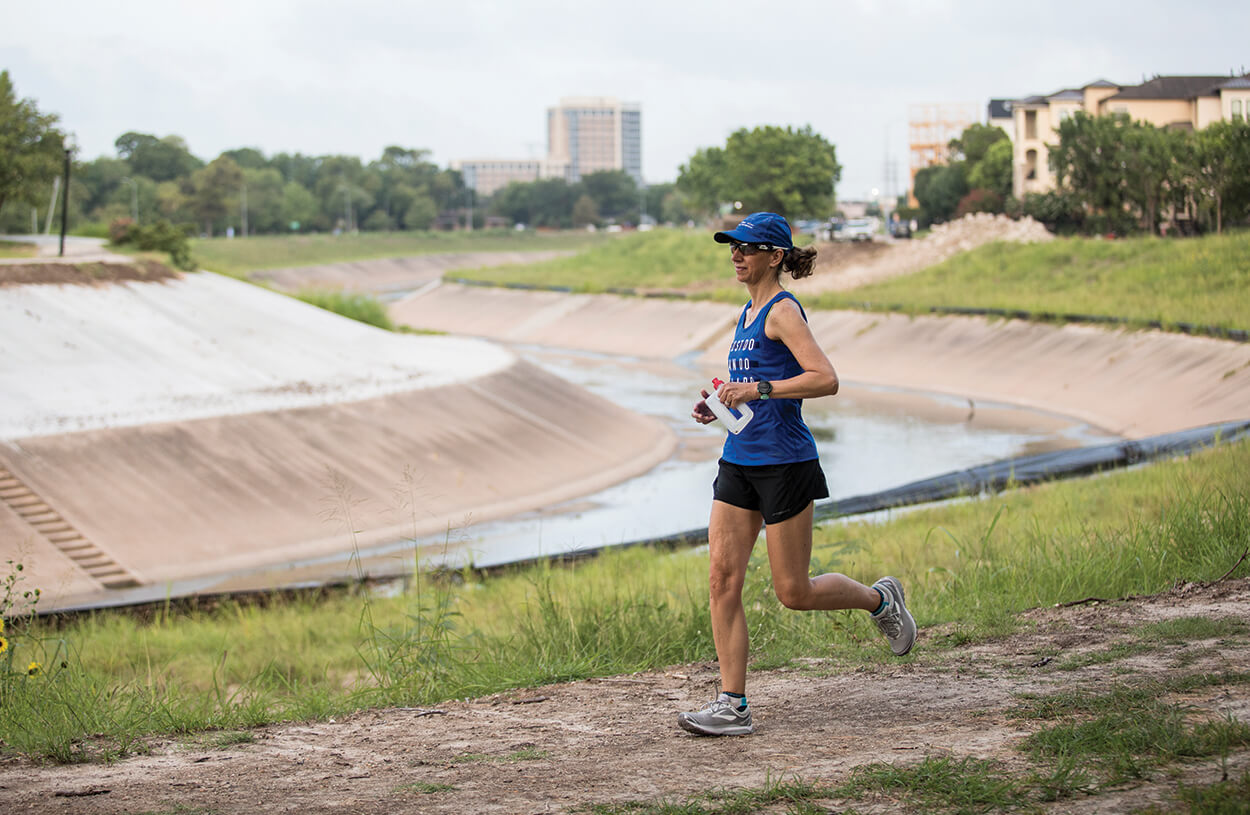
Richards-Kortum jogs along Brays Bayou on a mid-July morning.
A $100 million plan
Currently, eight of the 17 items in the NEST360° toolkit are commercially available, while the remaining nine are in various prototype and testing stages. Many of the devices were initially designed by students at Rice and tested and refined by teams in Malawi. This innovation is an all-hands-on-deck effort, with Richards-Kortum and her collaborators working tirelessly—even through disappointment and frustration—to bring the suite to life.
Late last year, NEST360° vied for a grand prize of $100 million in the MacArthur Foundation’s inaugural 100&Change competition. For months, the team—which included members from Houston, Malawi, Tanzania and Nigeria, along with collaborators at Northwestern University, The London School of Hygiene and Tropical Medicine and 3rd Stone Design—worked on a proposal for the prize money that would implement and sustain the full suite of technology. The team made it to the final round, but fell short of what would have been the final piece of their financial puzzle.
Richards-Kortum was quick to mention that the MacArthur Foundation generously awarded each finalist $15 million. It’s a seed she’s been laser-focused on nurturing since.
“We made a $100 million plan and we’re working on bringing together a group of partners to try to fund the project as a whole,” she said. “I think solving a problem of this size—it’s not a $15 million problem. And the thing that was exciting about the plan that we made was that it really allowed us to take a systems approach and think about all the things that need to change to allow you to get to scale and be able to sustain that afterwards without constantly needing more philanthropic support.”
She knows $85 million is a lot of money, but it’s a matter of perspective. And priorities.
“There are hotel renovations that cost more than $85 million,” Richards-Kortum said.

